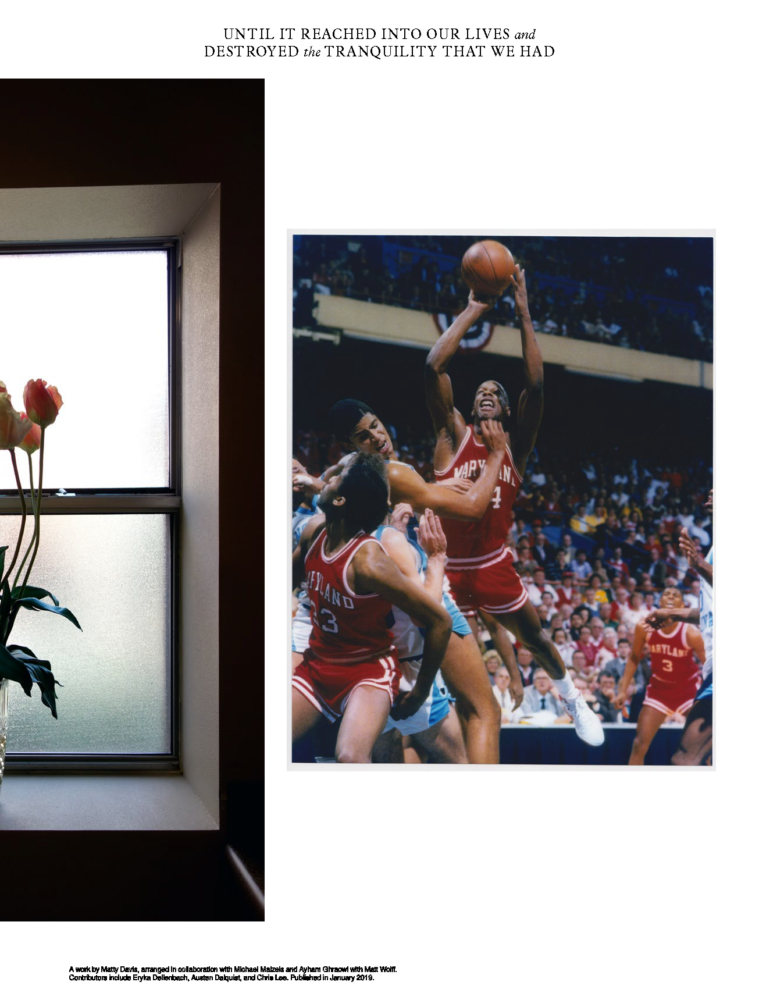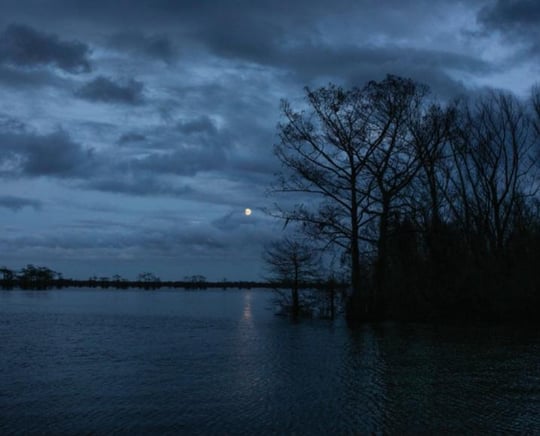
Focusing on remote sites in northwest Arkansas which allegedly served as training grounds for covert CIA operations in Central and South America, Until it reached into our lives and destroyed the tranquility that we had is an artist’s book produced by artist Matty Davis in collaboration with Ayham Ghraowi, Matt Wolff and Michael Maizels. (Maizels curated an exhibition of the same name featuring Davis’s related artwork at the University of Arkansas in 2018.) During the Clinton era, what once was an unhurried, unbothered state became the center of international scrutiny and myriad conspiracy theories and political scandals. Until it reached into our lives… reexamines those intersecting moments—from Barry Seal’s cocaine smuggling through the sundown town of Mena to the fumbling cover up of the murder of two teenage boys in 1987 to the violence inflicted upon poor rural communities by America’s War on Drugs. Until it reached into our lives and destroyed the tranquility that we had attempts to align disparate narratives into an intimate story of a small, isolated place. Editor Logan Lockner spoke to Matty Davis about the project.
Logan Lockner: Beyond the details of these particular conspiracy theories, what your project reveals is a profound and pervasive breach in public trust, which leads to certain questions: How do we trust the archive or the historical record? How do we trust our own government? And, perhaps most disturbingly, how do we trust our own perceptions and suspicions? In what ways is this a project about uncertainty and doubt, and how is that reflected in the form of the book itself?
Matty Davis: Until it reached into our lives and destroyed the tranquility that we had—in the case of both the book and the body of work that includes sculptures, drawings, performance, and film—doesn’t contain any images of historical records/archival material nor any related textual transcriptions. In terms of records, we worked mostly the Special Collections at the University of Arkansas. I was most interested in various documents that pointed toward particular people and places, still alive and intact. I wanted to go there—to the person, to the forest, to the airport, to the malleable, generative sites. Inside people and land, information is fragile. We’re also talking about a history that spans decades, so people have passed away, and history has passed with them; land changes hands and is repurposed. Without any inherent distrust in memos, transcripts, and other records, I was more interested in working with living documents, people and places, and in exploring how various events—both confirmed and alleged—had affected them, changed them, haunted them. It’s about lives and how they’re shaped.

In the context of this question, “the government” feels to me like an analogue for the grandiose conspiracies hanging over Arkansas, which conjure big names like Bill Clinton, the CIA, Barry Seal, and Oliver North. This stuff can feel so larger than life and abstract that it’s hard to wrap your head around and get close to. I went the other direction. We sat with a Mena-based aviator at this kitchen table, his dogs barking through the screen door. We wrestled through the forest with a guy who grew up around Mena in an effort to touch these covert sites with our own hands. I opted for a more intimate, grounded approach, which often concerned stuff that would likely never make headlines in itself, but whose meaning could be as profound and dramatic as anything. I felt like this work exercised trust between people, and in relation to our own bodies and instincts. I feel the book and body of work actively wades through doubt and uncertainty. I think the spirit of a “search” is very alive.
LL: While the story the book tells primarily unfolds in the context of the American South (namely, rural Arkansas), the larger conspiracy regarding CIA-trained operatives in Central and South America means this is also a story about the Global South and the ways in which that region intersects with more localized “souths.” What does this project demonstrate about “the South,” whether American or global?
MD: I’m hesitant to speak too much or too generally about this, as my experience with the southern U.S. is very limited, and my experience with the Global South almost non-existent. I will say that my experience in Arkansas was a bit more cowboy than I’m used to. Privacy and personal freedom felt abundant, and of course these things aren’t always used to good ends. With regard to Arkansas being a node within a national and international network of covert global activity, the person who is referred to as MS in the book once asked us, “Where do you wanna be when the world ends? Arkansas. Why? Because here everything happens fifty years later.”
LL: Can you speak a little bit about your work before and since this project?
MD: Curator Michael Maizels invited me to do something in relation to this history in Arkansas partially after seeing a video from Between Heaven and Earth (2016), a body of work based on a nineteen-day 509 mile run I did according to the flight path of an airplane that crashed between Chicago and Pittsburgh. I think my engagement with the land and technology from an extremely physical perspective was intriguing to him. Another massive part of my practice, both before and after this body of work, involves making performances. These are very physical, with rigorous movement and choreographic research, often to some degree site-specific, and frequently in collaboration with others. I have a pretty robust dance background and am probably above all invested the body’s energy systems and resources, including trust, resilience, and care. Immediately after the exhibition in Arkansas, I was working on five performances commissioned for a video work by Hito Steyerl that was shot in the Park Avenue Armory (opening June 20). These all took place in highly unconventional spaces, from the massive drill hall to the former shooting range in the Armory’s basement. I’m currently working on a new performance with Eryka Dellenbach (whose work is featured in the book) that involves a slew of odd objects comprised comprised of lead, cast iron, and wood planks made from now extinct Longleaf Yellow Pine. These objects are cast between each other in various ways to explore power and difference.

LL:You’ve worked with a wide variety of people—including Arkansas locals, art historians, and NCAA athletes—for this exhibition and publication. Why is working with collaborators so important to you, and why was it necessary for the success of this project in particular?
MD: I felt that it would be disingenuous to try to understand this land and its history by myself. Some of the history addressed took place well before I was born, and certain key collaborators were doing important work in Arkansas while I was still in diapers. Coming to Arkansas as an outsider, perhaps I could see certain things that a native couldn’t, but I really needed to try to see through the eyes of others living and working there. It felt vital to both keeping us safe and to making the work as rich as possible. Chris Lee is a contractor based in Fayetteville, but being from Mena he was familiar with how people might be inclined to treat trespassers, for example, and was aware as to what kind of wildlife we might expect to encounter. I didn’t pack a machete, and I’m glad he brought one!
More conceptually, history and lives exist in relation to one another and become meaningful through various interpersonal and social webs. It was incredible how one person’s theory of drug smuggling in Arkansas could leap toward the tragic death of [NCAA All Star basketball player] Len Bias, or how one person’s fear and misunderstanding could redirect our attention to the murder of Don Henry and Kevin Ives. I needed to talk to people, and that often happened by working with others; I needed different skill sets to activate the land in various ways, as when Austen Dalquist (an elite NCAA runner) performs a linear mile on runway Bravo at Mena Intermountain Airport. Of course, in order to make that happen, we needed to work with the airport manager Fred Ogden. In lots of ways we were helping each other, goading each other, protecting each other so as to make certain actions and revelations possible.
Until it reached into our lives and destroyed the tranquility that we had is an artist’s book by Matty Davis in collaboration with Ayham Ghraowi, Matt Wolff and Michael Maizels. The book will be presented by Printed Matter at the LA Art Book Fair in April and is available to purchase from Printed Matter’s online store. An exhibition of the same name featuring artwork by Davis and curated by Maizels was presented at the University of Arkansas, Fayetteville, from August 31 through October 7, 2018.





